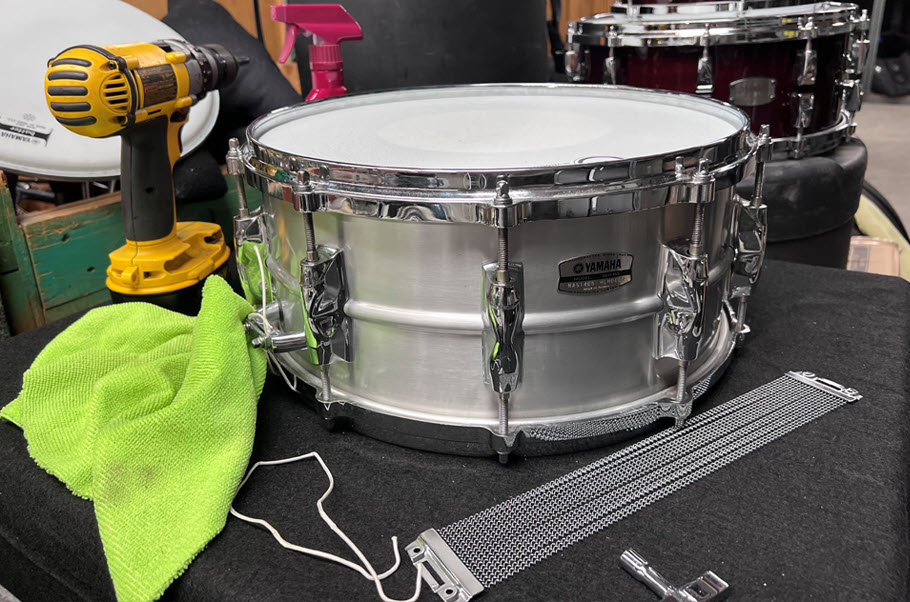So Your Child Wants to Learn to Play Drums, Part 3
Electronic drums for the beginner student.
In Part 1 of this three-part series, we talked about the general differences between an acoustic drum set and an electronic one – and in Part 2 we focused on the acoustic variety. Let’s wrap things up with a detailed look at electronic drums.
Cost Versus Quality
If you’re shopping for electronic drums, you’ll find that the market is full of low-cost options. But remember, your child will be physically hitting the drums and many cheaper kits will fail over time due to heavy use. More expensive electronic kits tend to be more robust, feel more realistic and offer larger playing surfaces similar in size to those found in an acoustic drum kit. For beginning students, look for an electronic drum set that is priced similarly to a good quality, entry-level acoustic one – it will offer better value as well as a variety of great sounds for your child to enjoy during their practice and learning.
Module
The module – sometimes known as the “brain” of an electronic drum set – generates the sounds that you hear when connected pads are struck. The quality of the chips inside the module play an important role in keeping your young drummer more engaged. The better the sounds, the more fun it is to play! Modules are sometimes advertised as having thousands of sounds, but keep in mind that quantity isn’t everything. The sounds should be useful, realistic and have an authentic “latency” (that is, the appropriate amount of time from the instant a player hits the pad to when the sound is heard). Creating lots of sounds that meet this criteria – without eating up memory – adds cost, so entry-level kits typically have fewer sounds.
You may also want to strongly consider purchasing an electronic drum kit that allows your child to edit and/or create their own sounds. Young students love to tinker!
Training Functions
One big advantage to electronic drums are the built-in training functions that allow the aspiring musician to improve the critical skills of timing and feel. This can include built-in songs the student can play along to, making training and practice more fun – and therefore ultimately more successful.
Drum and Cymbal Pads
There are several types of drum and cymbal pads available. When choosing, look for a good feel that pairs well with the sounds of the module. You can have a very good pad and an average module – or vice versa. To a certain degree, having one element of better quality may help enhance the capabilities of the other, but eventually you’ll find that the response of the pad is the most important factor.
Another thing to consider is the feel of the pads as compared to acoustic drums. Most likely, your child will be playing acoustic drums if they end up performing in school or other live settings. Look for pads that have a rebound that’s similar to acoustic drums and traditional practice pads. Unlike acoustic drum heads, electronic pads tend to have a similar feel from one to the next. As a result, rubber pads are generally used in less expensive starter electronic drum sets, although some may offer mesh or foam.
Rack/Hardware
Racks or stands are used to hold electronic drums in place and are an important part of the playability factor. Small racks tend to be used for smaller pads and so the spacing can be very different than that of an acoustic drum set, making for a dissimilar experience. Electronic drum sets like these can take time to feel natural, especially if moving between acoustic in performance and electronic for practice. Large racks, on the other hand, can accommodate larger pads, making the spacing much more realistic. This in turn gives the student a more authentic practice experience. Spacing can influence the kit’s durability too, since allowing proper playing position and being able to keep things stable once the kit is set up (as opposed to constantly loosening and tightening knobs) can cut down on the wear and tear of the mounting hardware.
Some Things to Consider in an Electronic Kit
1. Sounds: There’s usually a direct relationship between the price of a module and the quality and variety of sounds it offers. Top-notch modules include all the standard drum set sounds you would expect, but also offer many other instruments such as bells, wood blocks, special effects, non-percussion instruments and much more. High-end modules also allow you to edit and create your own sounds, and in some cases, allow you to download your own samples. Modules with download capabilities can cultivate creativity!
2. Preset patterns: Every module has a selection of preset patterns, typically, short two-bar patterns or drum parts related to specific drum kits or musical styles. As mentioned earlier, these can be valuable learning tools, as well as a source of inspiration in creating your own unique drum parts. Many modules include full play-along tracks for both fun and practice.
3. Connectivity and expansion: If you plan to expand your child’s electronic kit with more pads and triggers in the future, be sure the module has enough connectors to allow this. A USB port lets you send MIDI data to external PCs, digital audio interfaces and workstations – giving you access to a wide range of music software. Audio inputs for connecting MP3 or CD players let you practice and play along with your favorite music. Multiple outputs that can send your performance simultaneously to a mixer and recorder can be useful in both live and studio settings. Also, be sure that the outputs will support the type of amplification system you plan to use.
Features to Look for in an Electronic Kit
1. A module that is simple to use and sounds well: It should also allow you to download new kits and customize existing kits with fresh sounds and capabilities. There’s no better way to keep your child engaged!
2. Pads that are sturdy and have a good feel when played: They should have some give, but not too much rebound or bounce.
3. A rack that has sufficient weight to keep things in place yet easy to adjust: The mounting hardware of your electronic drum kit should make it easy to keep components in place, using a standard drum key or knobs that stay tight.
4. Durability: Anything your student hits with a stick should have some mass – and feel sturdy.
Things to Avoid in an Electronic Kit
1. A module with significant limitations: If it doesn’t allow you to personalize the feel of the kit or limits the number of pads you can add (due to only a few or single-zone inputs), keep looking.
2. A module that has poor sounds: Unlike acoustic drums, you can’t fix the sounds of an electronic kit with well-placed tape or muffling.
3. Pads that feel too hard: This can can cause fatigue for younger hands.
4. Pads that feel flimsy: Typically, these will not hold up under normal playing conditions – especially at the hands of a child.
5. Pads that are too bouncy: These can make transitioning to an acoustic drum kit difficult.
That about wraps it up for electronic drums – and our series. If you haven’t had an opportunity, check out Part 1 and Part 2 of this three-part series for more information.
Good luck to you and your burgeoning young drummer!
Click here for more information about Yamaha drums.












